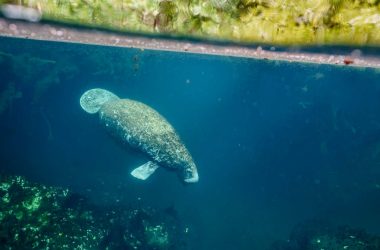A turtle being examined for potential radioactivity in the Marshall Islands in 1957
National Archives
Turtles and tortoises can retain a historical record of exposure to radioactive contamination on their shells.
These reptiles accumulate radioactive uranium isotopes on their shell scales when they come into contact with nuclear weapons testing fallout or accidental waste releases. This discovery could have implications for long-term monitoring of radionuclides in nature, which are radioactive variations of elements.
Radionuclides from nuclear activities have spread widely and persist in ecosystems for extended periods of time. In the United States, it is estimated that up to 80 million cubic meters of soil and 4.7 billion cubic meters of water are contaminated from past nuclear activities.
Testing for the accumulation of radionuclides in organisms poses challenges, according to Cyler Conrad from the Pacific Northwest National Laboratory in Washington state. For example, tree rings can contain radionuclides, but they can diffuse within the wood between rings, making the chronological record unreliable.
Conrad and his colleagues investigated whether the tough scales, known as scutes, on turtle and tortoise shells could offer a more reliable option. These scales grow in layers and, once deposited and separated from other bodily tissues, provide a time-stamped record.
The researchers analyzed scutes from four museum specimens of turtles, each from a different species and location that had historical exposure to nuclear materials. The subjects included a green sea turtle from the Marshall Islands, which had nuclear weapons testing in the mid-20th century, and a Mojave desert tortoise from Nevada, also exposed to nuclear testing.
The other two turtles were from fuel processing sites that caused contamination through nuclear waste. The researchers also studied a desert tortoise from an area unrelated to nuclear activity.
Chemical analysis of small scute fragments revealed that the four turtles from historical nuclear sites had slightly elevated levels of uranium radionuclides in their shells. An eastern box turtle living near the Oak Ridge National Laboratory in Tennessee showed a uranium signature in its scute growth rings between 1955 and 1962, corresponding to the timing of airborne waste releases at the site.
The team believes that these uranium-chronicled turtles could be used to reconstruct the history of nuclear contamination in ecosystems.
Germán Orizaola from the University of Oviedo in Spain suggests that this study could open doors for radioecology research using zoological collections in museums, enabling researchers to assess the concentration of radionuclides in feathers, bones, and other tissues in specimens collected before and after nuclear tests and accidents.
The researchers only required a very small amount of shell tissue for their analysis, leading Clare Bradshaw from Stockholm University in Sweden to wonder if the technique could be applied non-invasively to living turtles and tortoises as well.
Conrad also sees the potential application of these findings in measuring and studying living turtles to understand the current state of our environment in relation to radionuclide accumulation.












